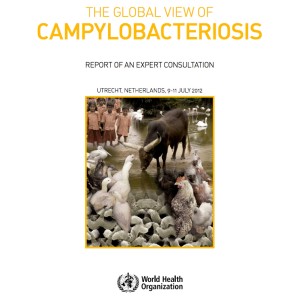From July 9-11, 2012, the World Health Organization (WHO), in collaboration with the Food and Agriculture Organization of the United Nations (FAO) and the World Organisation for Animal Health (OIE), convened an Expert Consultation on The Global View of Campylobacteriosis, in Utrecht, Netherlands.
Below are the general conclusions:
Considerable new evidence, data, and analytical tools have emerged in the ten  years since the previous WHO consultations on Campylobacter.
years since the previous WHO consultations on Campylobacter.
In terms of public health actions, there is already a sufficient evidence base to address the burden of disease from C. jejuni and C. coli. The importance of other species in terms of burden of disease is still unclear, but is considered unlikely to eclipse these two species.
Public health surveillance can provide important basic information to policy-makers about the frequency of infection, who is affected, and the success of specific prevention strategies. Surveillance is the starting point for studies of burden of disease and source attribution.
There is a need for standardization and validation of laboratory methods.
Burden of disease studies provide the evidence base that drives the need for control measures across all outcomes of Campylobacteriosis while taking into consideration its underestimation.
There is considerable potential for the identification of new sequelae from acute infection. However, decision criteria are needed on the level of evidence required to add outcomes to burden estimates. This applies to all sequelae, and may increase burden estimates considerably.
In order to reduce exposure countries should be encouraged to adopt the recently developed Codex Guidelines for the Control of Campylobacter and Salmonella in chicken meat which promote a risk based approach to the management of Campylobacter in chicken meat traded internationally.  Consideration should be given to the development of additional guidance and recommendations for the management of Campylobacter in other potential food vehicles that are traded internationally.
Consideration should be given to the development of additional guidance and recommendations for the management of Campylobacter in other potential food vehicles that are traded internationally.
Source attribution studies should adopt a holistic attitude, considering multiple sources and pathways of exposure. Where possible attribution estimates should combine both molecular tying and epidemiological data and include measures of uncertainty.
Although poultry is the dominant source of infection in many countries, controlling Campylobacter in poultry meat will not completely eliminate the disease in humans. Options are available to control other pathways which are based on general hygiene, generic control measures including biosecurity and sanitation.
Reducing the load of Campylobacter in poultry to a level with a low probability of causing illness is unlikely to be achieved by any single pre-harvest or post-harvest intervention. Success will most likely occur through use of multiple stepwise interventions to lower the load of Campylobacter on or in each bird on the farm and in the processing facility.
The epidemiology of Campylobacteriosis is likely to be different in high-income countries versus LMIC. This will affect control options.
GFN, as an international training and capacity development network, will play a key role in promoting better and more consistent methodologies and quality assurance for work with Campylobacter. Where possible, GFN should link with other international networks, such as FERG, which is promoting capacity development in estimation of burden of foodborne disease.
The complete report is available at https://extranet.who.int/iris/restricted/bitstream/10665/80751/1/9789241564601_eng.pdf.
